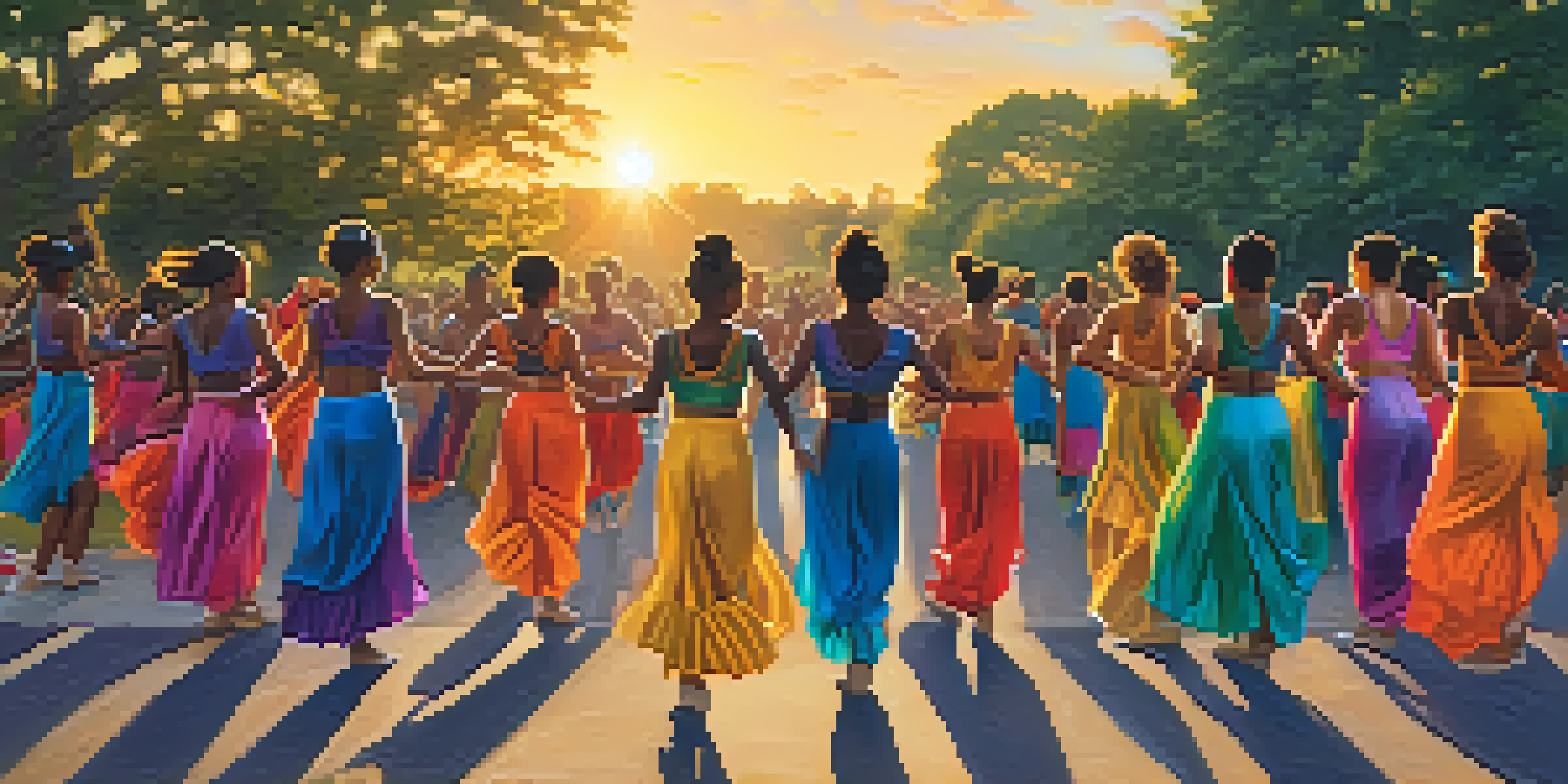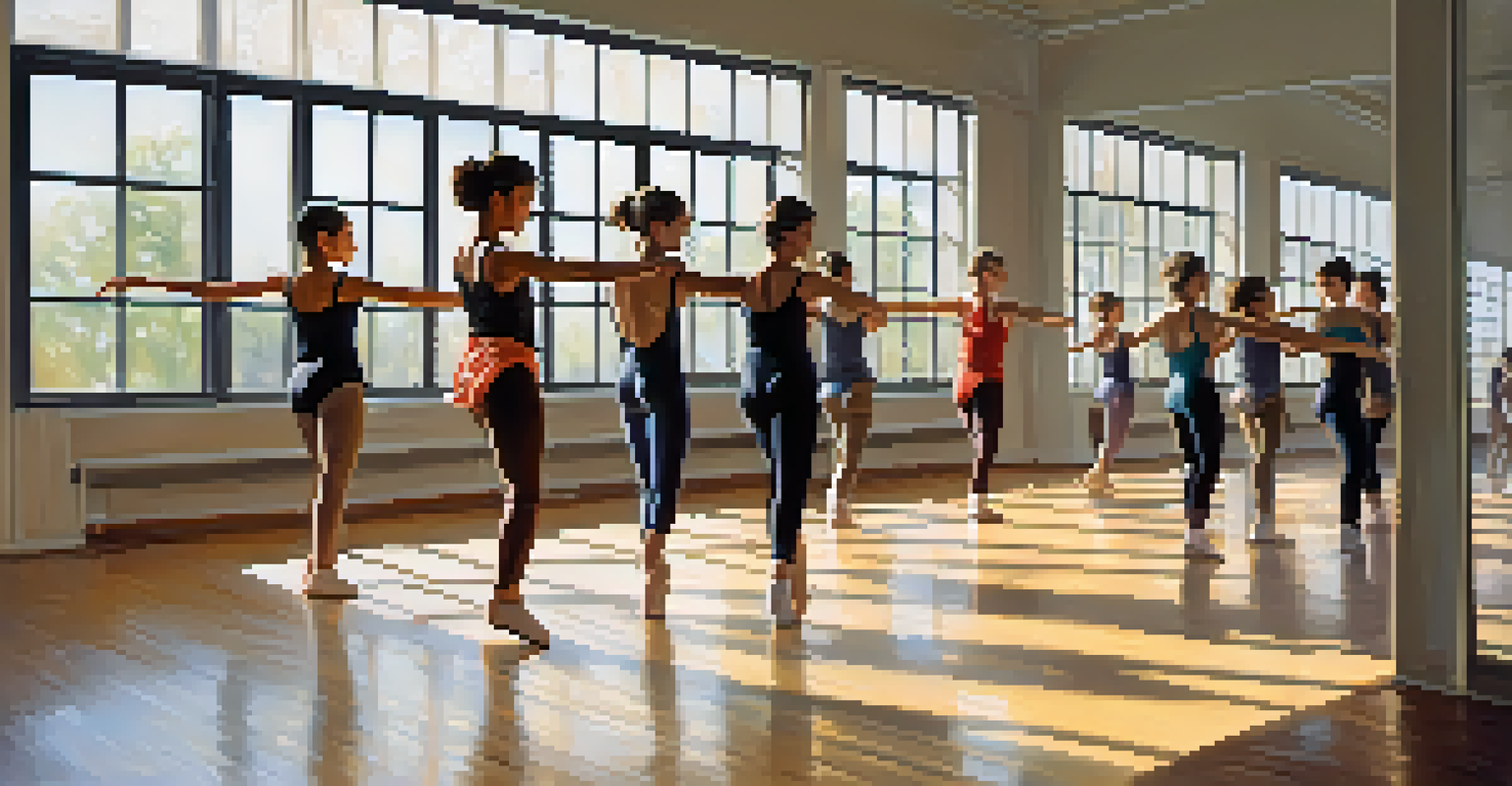Creative Outlets: Dance and Youth Empowerment Initiatives

The Transformative Power of Dance for Youth
Dance is not just a form of expression; it's a powerful tool for personal growth, especially among youth. It allows young people to explore their identities, build confidence, and discover their voices. When they dance, they aren't just moving to the music; they're telling their stories and expressing emotions that words may fail to capture.
Dance is the hidden language of the soul.
Moreover, dance provides a safe space for youth to connect with others who share similar interests and experiences. This sense of community can be crucial during formative years, as it fosters belonging and acceptance. Through collaborative choreography or group performances, young dancers learn the value of teamwork and support.
Participating in dance can also help develop essential life skills such as discipline, resilience, and goal-setting. Whether preparing for a recital or mastering a challenging routine, youth learn to push through obstacles and celebrate their achievements, instilling a sense of pride and accomplishment.
Youth Empowerment Initiatives Through Dance Programs
Various organizations have recognized the potential of dance as a means of empowerment and have established programs aimed at young people. These initiatives often focus on underserved communities where access to the arts may be limited. By providing free or low-cost classes, they open doors for youth to explore their creativity and talents.

Such programs not only teach dance techniques but also emphasize personal development. Workshops often include discussions about self-esteem, leadership, and community involvement, ensuring that participants leave with more than just dance skills. This holistic approach nurtures well-rounded individuals who feel equipped to take on challenges.
Dance Fosters Youth Empowerment
Dance programs empower youth by promoting personal growth, self-expression, and community engagement.
Moreover, these initiatives often encourage participants to give back to their communities, fostering a sense of responsibility and connection. By engaging in performances or community service, youth learn the importance of using their talents for a greater good, thereby amplifying their empowerment journey.
Building Confidence and Self-Esteem Through Dance
For many young people, dance serves as a platform to build confidence and self-esteem. The very act of performing in front of an audience can be daunting, but it also provides a unique opportunity to shine. Over time, as they gain experience and receive positive feedback, their self-image can transform immensely.
Dance is the joy of movement and the heart of life.
Additionally, dance encourages self-expression in a way that is often difficult to achieve through other mediums. When youth feel empowered to express their emotions and thoughts through movement, they learn to embrace their individuality. This acceptance of self is crucial in a world where external pressures can make them feel less than adequate.
As they learn to celebrate their uniqueness on stage, they often find that confidence spills over into other areas of their lives. Whether it's speaking up in class or participating in sports, the self-assurance gained through dance can significantly impact their overall personal and social development.
Creating Inclusive Spaces for All Youth
Inclusivity is a key component of many dance programs aimed at youth empowerment. These initiatives strive to create environments where all young people, regardless of their background or ability, can participate and thrive. By promoting diversity, they ensure that every voice is valued in the dance community.
Programs often adapt their teaching methods to accommodate varying skill levels and physical abilities. This approach not only makes dance accessible but also reinforces the idea that everyone has something unique to contribute. Such inclusivity fosters respect and appreciation among peers, building a stronger community.
Inclusivity in Dance Programs
Inclusive dance initiatives ensure that all young people, regardless of background or ability, can participate and thrive.
Ultimately, by celebrating differences and promoting acceptance, dance programs play a vital role in shaping a more inclusive society. Youth learn to appreciate the beauty in diversity, which can lead to greater empathy and understanding both inside and outside of the dance studio.
Dance as a Tool for Emotional Expression and Healing
Dance has long been recognized for its therapeutic benefits, particularly when it comes to emotional expression. For many young people, it acts as a channel to release pent-up feelings, whether it's joy, sadness, or frustration. Engaging in dance allows them to process emotions in a constructive manner, promoting mental well-being.
Through movement, youth can explore complex emotions that may be difficult to articulate verbally. Dance offers a safe outlet for self-exploration, helping them navigate their feelings and experiences without fear of judgment. This process can be especially beneficial for those facing challenges such as anxiety or trauma.
Moreover, dance therapy programs often incorporate mindfulness techniques, allowing participants to connect with their bodies and thoughts. This holistic approach not only aids in emotional healing but also encourages resilience, teaching young people that it's okay to feel and that they have the power to overcome life's challenges.
The Role of Community in Dance Empowerment
Community support is essential when it comes to empowering youth through dance. Local organizations, families, and peers play a crucial role in fostering an environment where young dancers can flourish. When communities rally around their youth, offering encouragement and resources, the impact can be profound.
Events such as dance showcases or competitions often serve as a platform for community involvement. These gatherings not only celebrate the talents of young dancers but also strengthen community bonds. When families and friends come together to support their local youth, it creates a sense of pride and connection.
Community's Role in Dance Success
Community support is vital for empowering young dancers, providing encouragement, resources, and opportunities for growth.
Furthermore, community partnerships can enhance dance programs, providing funding, venues, and mentorship opportunities. This collaborative approach ensures that young dancers have access to the tools they need to succeed, ultimately amplifying the benefits of dance as a means of empowerment.
Future Trends: The Evolution of Dance and Youth Empowerment
As society continues to evolve, so does the role of dance in youth empowerment. With the rise of technology and social media, young dancers now have the opportunity to share their art with a global audience. This connectivity can inspire creativity and foster a sense of belonging among youth, no matter where they are.
Moreover, virtual dance classes and workshops have become increasingly popular, allowing more young people to access quality instruction. This shift not only breaks geographical barriers but also ensures that youth from various backgrounds can participate and benefit from dance programs.

As we look to the future, it's clear that dance will remain a vital outlet for youth empowerment. By embracing new trends and adapting to the changing landscape, dance initiatives can continue to thrive, empowering the next generation to express themselves and create positive change in their communities.